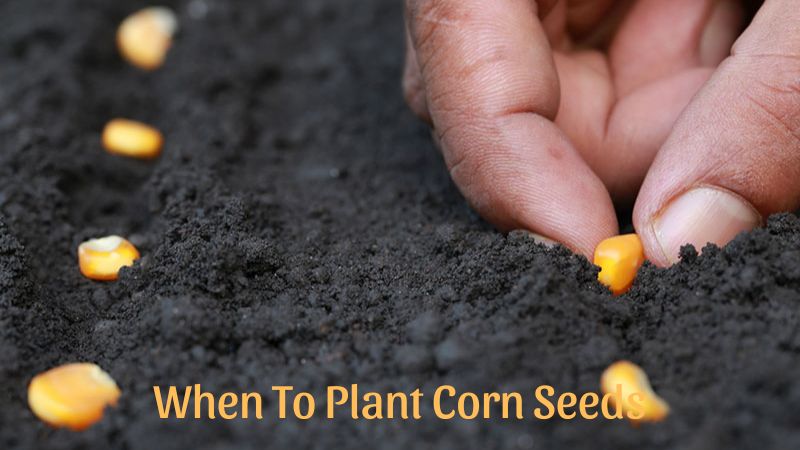Corn, also known as maize, is a staple crop in global agriculture, not only an important food source but also a key raw material in many industries. To successfully cultivate corn, choosing the right time and conditions for planting is indispensable. Understanding when to plant corn seeds helps farmers optimize the yield and quality of their crops, thereby bringing high economic benefits. In this article, Garden Creatives will explore the ideal time and necessary factors for optimal corn planting.
When to plant corn seeds: Ideal Time and Conditions for Cultivation
Ideal corn planting time
When to plant corn seeds on many factors, including climate, corn type, and soil conditions. Here are some factors to consider when choosing the right time to plant corn:
Seasonal time
When to plant corn seeds usually planted in spring and summer, depending on the climate zone. In temperate climates, corn planting time usually starts from late April to early June. Meanwhile, in tropical and subtropical regions, corn can be planted year-round, but spring and summer are still the most common.
Spring: This is the ideal time to plant corn in many parts of the world. When the soil is warm enough, usually from late April to early June, the corn seeds will germinate and grow rapidly.
Summer: In areas with long, warm summers, corn can be grown throughout the summer. However, care must be taken to ensure adequate watering and to protect the plants from the sun.
Temperature
Corn grows best at temperatures between 21°C and 30°C. The minimum soil temperature for sowing corn seeds is around 10°C. If the soil temperature is too low, corn seeds will germinate slowly and are susceptible to disease. Therefore, it is important to check the soil temperature before planting.
Daytime temperature: Between 21°C and 30°C is the ideal temperature range for corn growth.
Nighttime temperature: Below 16°C can slow corn growth.
Rainfall and irrigation
Corn needs a sufficient amount of water to grow, especially during the germination and flowering stages. However, too much rain or improper irrigation can cause waterlogging and root rot. Choosing the time to plant should consider the weather forecast to ensure that the corn will receive enough water without being flooded.
Germination stage: Keep the soil moist but not too wet.
Development stage: Water regularly, especially during important stages such as flowering and seed formation.
Ideal conditions for planting corn seeds
In addition when to plant corn seeds, environmental conditions and cultivation techniques also greatly affect the growth of corn. Here are the factors to consider:
Choosing the soil
Corn is suitable for loose, nutritious, and well-drained soil. The soil needs to be plowed thoroughly before planting to create a favorable environment for seed germination and root development. The ideal soil pH for planting corn is from 6.0 to 7.5.
Light loam: Helps the plant develop roots easily.
Alluvial soil: Rich in nutrients, good for the comprehensive development of corn plants.
Fertilizer and nutrition
Providing adequate nutrition for corn is an important factor in achieving high yields. Before planting, organic fertilizer or chemical fertilizer rich in nitrogen, phosphorus, and potassium should be applied as basal fertilizer. During the growth process, it is necessary to periodically fertilize to supplement nutrients for the plant.
Organic fertilizer: Improves soil structure and provides long-term nutrition.
Chemical fertilizer: Provides instant nutrition, helping plants grow quickly.
Planting distance
Corn planting distance directly affects yield. Normally, the distance between corn rows is from 70 to 80 cm, and the distance between plants in the row is from 20 to 30 cm. Planting at a reasonable distance helps plants have enough space to grow and limits competition for nutrients.
Corn rows: 70 – 80 cm between rows.
Corn plants: 20 – 30 cm between plants in the same row.
Steps to plant corn seeds
After choosing the time and preparing the ideal conditions, you can proceed to plant corn seeds according to the following steps:
Sowing seeds
Sow corn seeds directly into the prepared soil or grow seedlings first and then transfer them to the field. If sowing directly, you need to make a hole about 2-3 cm deep and place the corn seeds in. Then, cover lightly with soil.
Watering
Immediately after sowing, water is needed to keep the soil moist. Make sure the soil is always moist but not too wet during the germination stage. When the corn plants have grown, adjust the amount
Corn Care
During the growth process, weeds need to be checked and removed to avoid competing with corn for nutrients. At the same time, monitor pests and apply timely control measures.
Weed removal: This should be done regularly to ensure that corn is not competing for nutrients.
Pest control: Use biological and chemical measures to protect the plant.
Important notes when growing corn
Choose the right corn variety
There are many different corn varieties suitable for each climate and soil condition. You need to choose a corn variety that is resistant to pests and suitable for the growing conditions of your area.
Pest control
Pests and diseases are one of the major challenges when growing corn. Fall armyworms, brown planthoppers, and diseases such as rust and root rot can cause serious damage. It is very important to apply timely and effective control measures.
Pollination
Corn is a cross-pollinated plant, so ensuring adequate pollination is essential to achieve high yields. Planting corn in rows helps the wind to easily disperse pollen and increase the pollination rate.
Harvesting at the right time
Harvesting corn at the right time will help ensure quality and yield. Corn is usually harvested when the kernels are fully ripe, bright yellow, and firm.
Conclusion
When to plant corn seeds at the right time and ensuring ideal conditions are important factors in achieving a bumper crop. By choosing the right when to plant corn seeds, preparing the soil well, and caring for the corn properly, you will be able to harvest corn with high yields and good quality. Hopefully, this article has provided you with useful information on when to plant corn seeds. Good luck!





